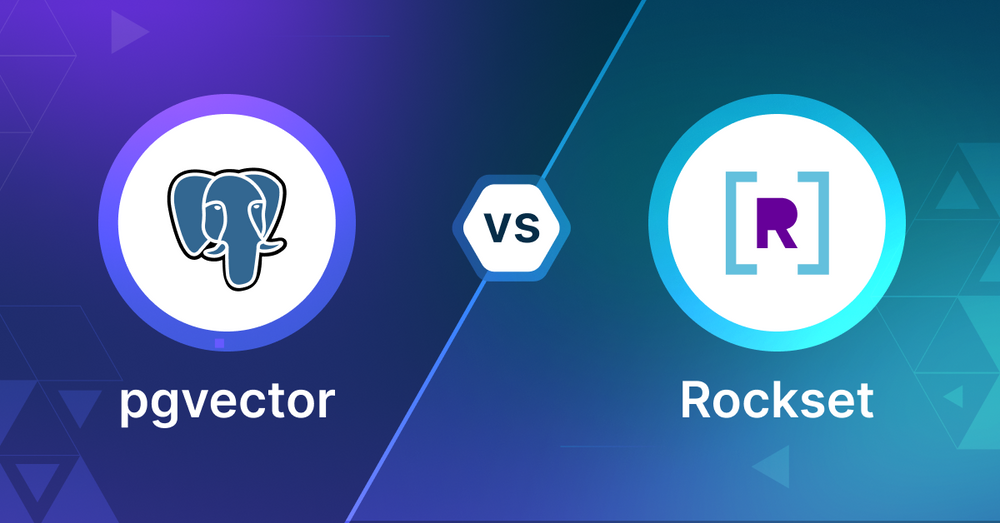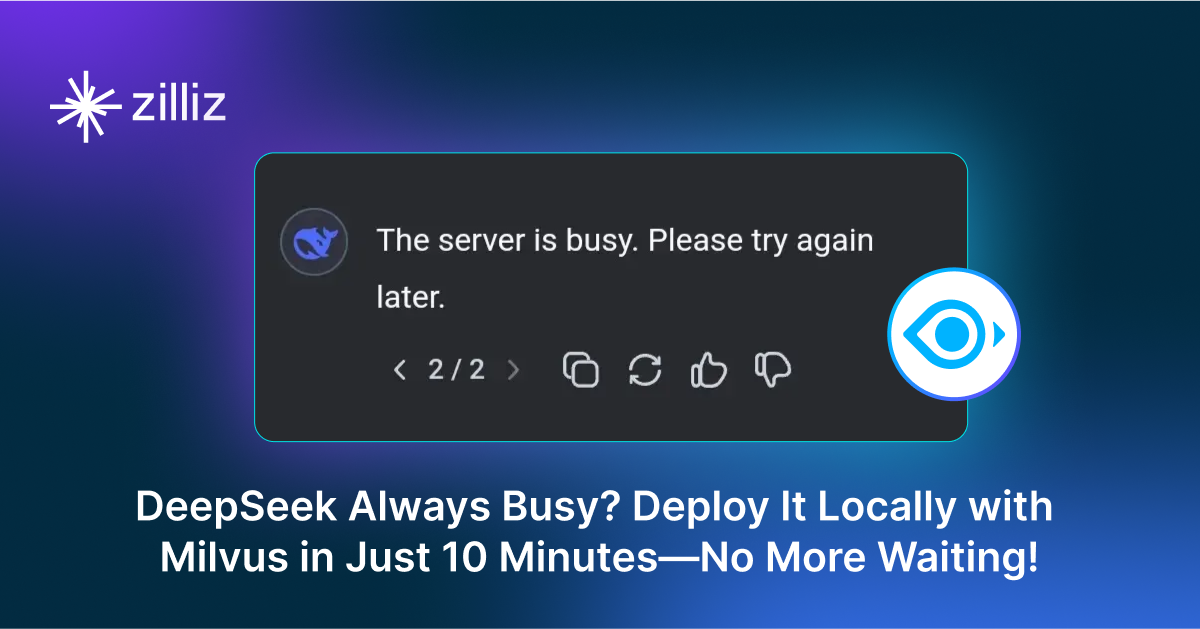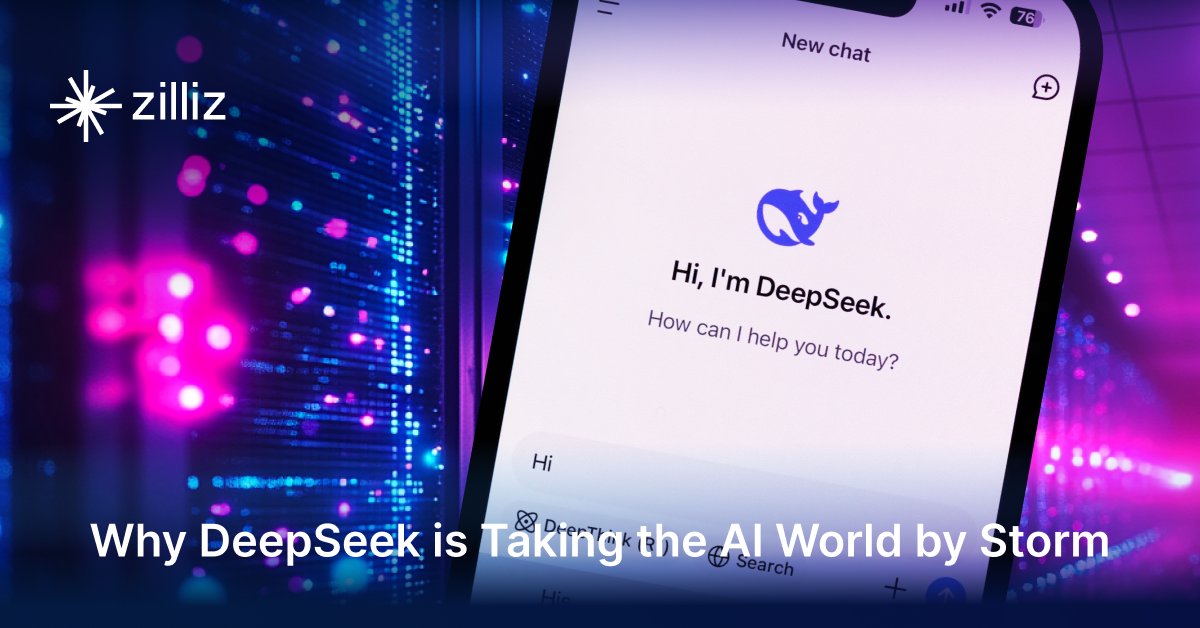pgvector vs Rockset: Choosing the Right Vector Database for Your Needs

As AI and data-driven technologies advance, selecting an appropriate vector database for your application is becoming increasingly important. pgvector and Rockset are two options in this space. This article compares these technologies to help you make an informed decision for your project.
What is a Vector Database?
Before we compare pgvector and Rockset, let's first explore the concept of vector databases.
A vector database is specifically designed to store and query high-dimensional vectors, which are numerical representations of unstructured data. These vectors encode complex information, such as the semantic meaning of text, the visual features of images, or product attributes. By enabling efficient similarity searches, vector databases play a pivotal role in AI applications, allowing for more advanced data analysis and retrieval.
Common use cases for vector databases include e-commerce product recommendations, content discovery platforms, anomaly detection in cybersecurity, medical image analysis, and natural language processing (NLP) tasks. They also play a crucial role in Retrieval Augmented Generation (RAG), a technique that enhances the performance of large language models (LLMs) by providing external knowledge to reduce issues like AI hallucinations.
There are many types of vector databases available in the market, including:
- Purpose-built vector databases such as Milvus, Zilliz Cloud (fully managed Milvus), and Weaviate
- Vector search libraries such as Faiss and Annoy.
- Lightweight vector databases such as Chroma and Milvus Lite.
- Traditional databases with vector search add-ons capable of performing small-scale vector searches.
pgvector is a traditional database with vector search capabilities as an add-on. Rockset, on the other hand, is a search and analytics database with added vector search capabilities. This post compares their vector search capabilities.
pgvector: Overview and Core Technology
pgvector is an extension for PostgreSQL that adds support for vector operations. It allows users to store and query vector embeddings directly within their PostgreSQL database, providing vector similarity search capabilities without the need for a separate vector database.
Key features of pgvector include:
- Support for exact and approximate nearest neighbor search
- Integration with PostgreSQL's indexing mechanisms
- Ability to perform vector operations like addition and subtraction
- Support for various distance metrics (Euclidean, cosine, inner product)
pgvector, by default, employs exact nearest neighbor search, which guarantees perfect recall but can be slower for large datasets. To optimize performance, pgvector offers the option to create indexes for approximate nearest neighbor search. This approach trades some accuracy for significantly improved speed, which is often a worthwhile tradeoff in many real-world applications.
It's important to note that adding an approximate index can change the results of your queries. This is different from typical database indexes, which don't affect the actual results returned. The two types of approximate indexes supported by pgvector are:
- HNSW (Hierarchical Navigable Small World): Introduced in pgvector version 0.5.0, HNSW is known for its high performance and quality of results. It builds a multi-layer graph structure that allows for fast traversal during searches.
- IVFFlat (Inverted File Flat): This method divides the vector space into clusters. During a search, it first identifies the most relevant clusters and then performs an exact search within those clusters. This can significantly speed up searches in large datasets.
The choice between these index types depends on your specific use case, considering factors like dataset size, required query speed, and acceptable trade-off in accuracy. HNSW generally offers better performance but may use more memory, while IVFFlat can be more memory-efficient but might be slightly slower or less accurate in some cases.
When implementing pgvector in your project, try to experiment with both index types and their parameters to find the optimal configuration for your specific needs. This process of fine-tuning can impact the performance and accuracy of your vector search operations.
Wanna learn how to get started using pgvector? Check out this tutorial!
Rockset: Overview and Core Technology
Rockset is a real-time search and analytics database designed to handle both structured and unstructured data, including vector embeddings. Its core strength lies in its ability to ingest, index, and query data in real-time, making it suitable for applications that require up-to-the-second insights. Rockset supports both streaming and bulk data ingestion, with the ability to process high-velocity event streams and change data capture (CDC) feeds within 1-2 seconds.
One of Rockset's key features is its Converged Indexing technology, built on mutable RocksDB. This allows for in-place updates of vectors and metadata, making it highly efficient for scenarios where data frequently changes. Rockset can handle document sizes up to 40MB and supports vector dimensionality of up to 200,000, making it suitable for a wide range of vector embedding applications.
Rockset integrates vector search capabilities as part of its core functionality. It supports both K-Nearest Neighbors (KNN) and Approximate Nearest Neighbors (ANN) search methods, using a distributed FAISS index for scalability. Rockset's approach is algorithm-agnostic, allowing for flexibility in search implementations. Its cost-based optimizer can dynamically choose between KNN and ANN search methods for optimal efficiency.
What sets Rockset apart in terms of vector search is its Converged Index, which combines search, ANN, columnar, and row indexes into a single structure. This allows for efficient handling of a wide range of query patterns out of the box. Rockset also supports metadata filtering and hybrid search, with its optimizer determining the most efficient query execution path. It can perform searches across multiple ANN fields, supporting multi-modal models, and offers both SQL and REST APIs for query interface flexibility.
Key Differences
pgvector vs Rockset: Vector Search Comparison
Search Methodology
pgvector supports both exact and approximate nearest neighbor search. It offers HNSW and IVFFlat indexes for approximate search and uses distance metrics like Euclidean, cosine, and inner product.
Rockset supports K-Nearest Neighbors (KNN) and Approximate Nearest Neighbors (ANN). It uses a distributed FAISS index for scalability and takes an algorithm-agnostic approach for flexibility. Rockset's cost-based optimizer chooses between KNN and ANN methods for optimal performance.
Data Handling
pgvector focuses on vector embeddings within PostgreSQL and works with structured data in PostgreSQL tables.
Rockset handles both structured and unstructured data. It supports vector embeddings up to 200,000 dimensions and can process streaming and bulk data, including CDC feeds.
Scalability and Performance
pgvector leverages PostgreSQL's indexing for performance. Exact search may be slower for large datasets, but approximate indexes improve speed at the cost of some accuracy.
Rockset is designed for real-time search and analytics. Its Converged Indexing allows for fast in-place updates, and it can handle high-velocity data streams. Rockset uses a distributed architecture for scalability.
Flexibility and Customization
pgvector integrates with existing PostgreSQL databases, allows vector operations like addition and subtraction, and offers customizable index parameters.
Rockset supports hybrid search combining vector and metadata filtering. It offers SQL and REST APIs for querying and can perform searches across multiple ANN fields.
Integration and Ecosystem
pgvector integrates seamlessly with the PostgreSQL ecosystem and can be used with existing PostgreSQL-based applications.
Rockset supports various data sources for ingestion and integrates with streaming platforms and data warehouses.
Ease of Use
pgvector is familiar for those already using PostgreSQL but requires understanding of PostgreSQL administration.
Rockset offers managed service options but may have a steeper learning curve for those new to the platform.
Cost Considerations
pgvector is open-source and free to use, with costs associated with running and scaling PostgreSQL.
Rockset likely has costs associated with its managed service, though specific pricing details are not provided in the given information.
Security Features
pgvector inherits PostgreSQL's security features.
When to Choose pgvector
Choose pgvector for projects already using PostgreSQL that need to add vector search capabilities, especially when combining traditional SQL queries with vector similarity search. It’s suitable for moderate scale vector search within a single database instance and for those who prefer an open source, self hosted solution with full control.
When to Choose Rockset
Choose Rockset for real-time analytics and search scenarios, especially with mixed structured and unstructured data. It’s great for fast ingestion and querying of high velocity data streams including vector embeddings. Rockset is ideal for large scale, distributed data environments that need to handle multiple data formats and sources and for those who prefer a managed service that scales automatically.
Conclusion
pgvector and Rockset both do vector search but for different use cases. pgvector integrates with PostgreSQL, for adding vector search to existing PostgreSQL applications. Rockset is for real-time analytics across multiple data types. Your choice depends on your use case, existing tech stack, data scale, real-time requirements and search complexity. Choose pgvector for PostgreSQL based projects with moderate vector search needs and Rockset for diverse, high velocity data environments that need real-time analytics and scalability.
While this article provides an overview of pgvector and Rockset, it's key to evaluate these databases based on your specific use case. One tool that can assist in this process is VectorDBBench, an open-source benchmarking tool designed for comparing vector database performance. Ultimately, thorough benchmarking with specific datasets and query patterns will be essential in making an informed decision between these two powerful, yet distinct, approaches to vector search in distributed database systems.
Using Open-source VectorDBBench to Evaluate and Compare Vector Databases on Your Own
VectorDBBench is an open-source benchmarking tool designed for users who require high-performance data storage and retrieval systems, particularly vector databases. This tool allows users to test and compare the performance of different vector database systems such as Milvus and Zilliz Cloud (the managed Milvus) using their own datasets and determine the most suitable one for their use cases. Using VectorDBBench, users can make informed decisions based on the actual vector database performance rather than relying on marketing claims or anecdotal evidence.
VectorDBBench is written in Python and licensed under the MIT open-source license, meaning anyone can freely use, modify, and distribute it. The tool is actively maintained by a community of developers committed to improving its features and performance.
Download VectorDBBench from its GitHub repository to reproduce our benchmark results or obtain performance results on your own datasets.
Take a quick look at the performance of mainstream vector databases on the VectorDBBench Leaderboard.
Read the following blogs to learn more about vector database evaluation.
Further Resources about VectorDB, GenAI, and ML
- What is a Vector Database?
- pgvector: Overview and Core Technology
- Rockset: Overview and Core Technology
- **Key Differences** 
- Search Methodology
- Data Handling
- Scalability and Performance
- Flexibility and Customization
- Integration and Ecosystem
- Ease of Use
- Cost Considerations
- Security Features
- When to Choose pgvector
- When to Choose Rockset
- Conclusion
- Using Open-source VectorDBBench to Evaluate and Compare Vector Databases on Your Own
- Further Resources about VectorDB, GenAI, and ML
Content
Start Free, Scale Easily
Try the fully-managed vector database built for your GenAI applications.
Try Zilliz Cloud for FreeKeep Reading

The Real Bottlenecks in Autonomous Driving — And How AI Infrastructure Can Solve Them
Autonomous driving is data-bound. Vector databases unlock deep insights from massive AV data, slashing costs and accelerating edge-case discovery.

DeepSeek Always Busy? Deploy It Locally with Milvus in Just 10 Minutes—No More Waiting!
Learn how to set up DeepSeek-R1 on your local machine using Ollama, AnythingLLM, and Milvus in just 10 minutes. Bypass busy servers and enhance AI responses with custom data.

Why DeepSeek V3 is Taking the AI World by Storm: A Developer’s Perspective
Explore how DeepSeek V3 achieves GPT-4 level performance at fraction of the cost. Learn about MLA, MoE, and MTP innovations driving this open-source breakthrough.
The Definitive Guide to Choosing a Vector Database
Overwhelmed by all the options? Learn key features to look for & how to evaluate with your own data. Choose with confidence.